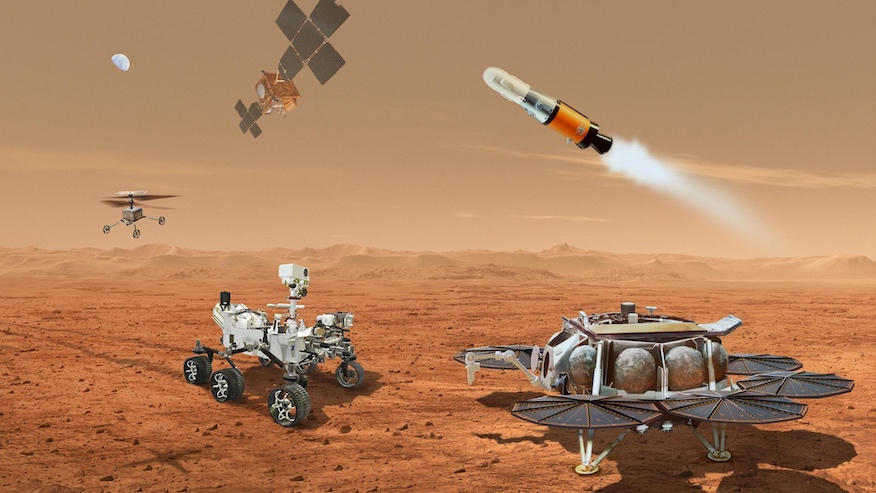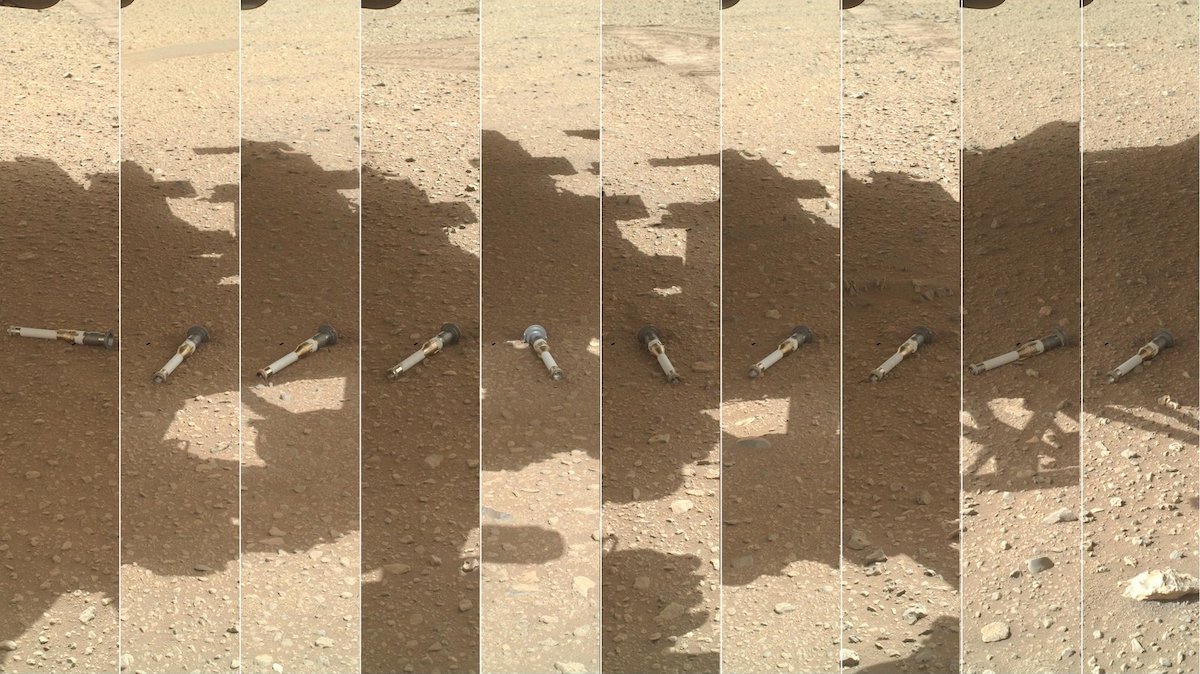
Credit: NASA/ESA/JPL-Caltech
NASA is going back to square one when it comes to many aspects of its Mars Sample Return mission in response to independent reviews that showed ballooning costs and significant schedule delays.
The current architecture called for no less than five separate vehicles to transport back to Earth more than two dozen samples collected on the Martian surface by the Perseverance rover, which has been traveling the Red Planet since 2021 and is the first of those.
“Every indication that we’ve had from the independent review boards, plus the [Inspector General], that this thing could cost up to $11 billion, which would cause NASA to have to cannibalize other programs,” Nelson said, referring to science programs, like the Dragonfly mission to Saturn’s moon, Titan, and the Near-Earth Object (NEO) Surveyor mission to find and track potentially hazardous objects.
That cost estimate of $11 billion came from the second MSR Independent Review Board (IRB-2) analysis in which it estimated needing between $850 million and $1 billion annually during the development period. Nelson pointed out that the Decadal Survey, an assessment of priorities from the science community via the National Science Foundation created every ten years, argued that it should cost approximately between $5 and $7 billion.
He described the $11 billion projection as being “too expensive” and a 2040 sample return date as being “unacceptably too long.”
“It’s the decade of the 2040s that we’re going to be landing astronauts on Mars,” Nelson said.
“I have asked our folks to reach out with a request for information to industry, to [the Jet Propulsion Lab] and to all NASA centers and to report back this fall an alternate plan that would get it back quicker and cheaper and try to stay within those limits.”

Shown, from left, are “Malay,” “Mageik,” “Crosswind Lake,” “Roubion,” “Coulettes,” “Montdenier,” “Bearwallow,” “Skyland,” “Atsah,” and “Amalik.” Deposited from Dec. 21, 2022, to Jan. 28, 2023, these samples make up the sample depot Perseverance built at “Three Forks,” a location within Mars’ Jezero Crater. Credit: NASA/JPL-Caltech/MSSS
A request for proposal will be published on April 16. That will be followed by an industry day on April 22 to field questions. Short proposals will be due on May 17 with a selection expected by Fall 2024.
Dr. Nicky Fox, the associate administrator of NASA’s Science Mission Directorate, also noted that the management structure of MSR would be changing as well. Instead of couching everything under JPL, it would instead move the different elements of the mission into standalone management.
“What we’re hoping is that we will be able to get back some more traditional, tried and true architectures, things that do not require huge technological leaps, but that have high heritage and thereby we can lower the risk and the cost and also the time for development,” Fox said. “Anything requiring huge leaps in technology, usually, from experience, takes a lot of time.”
Technological marvel with heritage products
The feat being carried out by the MSR is something never done before. It would require a lander, touching down on the surface of Mars, retrieving the samples collected by the Perseverance rover, sending them up to Martian orbit and then bringing them back to Earth.
The mission is being doing in partnership with the European Space Agency (ESA), which is assisting with the Earth Return Orbiter (ERO) along with the Capture Containment and Return System (CCRS).
In 2022, Lockheed Martin was selected as the prime contractor for three elements of MSR:
- $35 million – cruise stage of the lander
- $194 million – Mars Ascent Vehicle (MAV)
- $2.6 million – preliminary design of the Earth Entry System
Spaceflight Now reached out to see if those contracts are still in place and are waiting to hear back. The MSR IRB-2 Review Team (MIRT), which was formed to respond to the IRB-2 assessment, had a written recommendation was to launch the ERO/CCRS with ESA in 2030 and and to launch the Sample Retrieval Lander (SRL)/MAV in 2035.

During a teleconference with members of the press, Fox said that 2030 is a possible launch date for the ERO/CCRS, but that’s not a hard and fast date, noting it could change “when we see the results of the architecture studies.”
Fox said that proven technology with heritage is preferable for this new architecture as opposed to wholly new systems.
“If you have subsystems, you have pieces of architecture that’s been used before, then, that really does improve the risk posture and it removes any need to do a big technology development,” Fox said.
While a formal request for proposal won’t be published until Tuesday, in a social media post, SpaceX founder Elon Musk put forward the company’s Starship rocket, which aims to achieve full reusability over time.
Starship has the potential to return serious tonnage from Mars within ~5 years
— Elon Musk (@elonmusk) April 15, 2024
Impacts and budget challenges
Nelson said the goal of reducing the cost of MSR is to prevent it from having knock on effects for other key NASA priorities, like planned missions to Venus and Jupiter. During his remarks to the press on Monday, he pointed to congressional budgetary restrictions as part of their challenge.
In response, NASA decided on a $310 million budget for MSR in FY2024 and requesting $200 million for the FY2025 budget. Nelson said he was in communication with members of Congress and would be speaking with the Senate Appropriations Committee, which governs NASA, on Wednesday.
“They seem to be quite understanding of the predicament that we’re in and I take it back to the old country boy saying, ‘You can’t put 10 pounds of potatoes in a five-pound sack,’” Nelson said. “And so, we are trying to take the budget that we have been constrained with, a $2.5 billion hit and a billion of that is just in science and we’re trying to figure out how to make this go forward without hurting Dragonfly and NEO Surveyor and DAVINCI and VERITAS, all of these that are so important to the future of our planetary science program.”
In statements released by lawmakers on Monday, there seemed to be quite a bit of consternation. Rep. Judy Chu (CA-28) said she was “disappointed that after eight long months of review on the Mars Sample Return mission, NASA is only just now issuing a call for studies on the best path forward.”
“I am extremely concerned that NASA is proposing a funding level for MSR that will be insufficient for JPL to continue making robust progress on the mission without sacrificing its integrity,” Chu said. “It frustrates me that NASA has chosen the Planetary Science Decadal Survey’s highest-priority mission to absorb almost the entire share of funding reductions.”
California’s two senators, Sen. Alex Padilla (D-CA) and Sen. Laphonza Butler (D-CA), issued a joint statement, reiterating their hope that NASA would allocate “the full $650 million necessary to fund the MSR mission in NASA’s FY24 spending plan” and urged Nelson to “better balance these cuts so that the JPL workforce is protected and the mission proceeds while NASA and JPL evaluate if additional industry solutions are necessary.”
“These cuts will delay the mission at a critical time, further diminish our highly-skilled workforce, and significantly undermine California’s Jet Propulsion Laboratory and our state’s globally-leading science and space leadership as we face increasing competition with China,” the senators said. “These funding levels are woefully short for a mission that NASA itself identified as its highest priority in planetary science and that has been decades in the making.”
Regarding how the budget cuts may impact staffing at JPL, which experienced a round of layoffs in recent months, Fox said in a virtual town hall on Monday that they are working on providing guidance, but don’t directly control staffing there.
“NASA does not give any guidance or have any involvement in their workforce choices, but we do provide programmatic guidance and budget numbers,” Fox said. “So we are working closely with them. We do not have an answer today. We’ve not done the work at the NASA centers to look at what, if any, workforce reductions they would need to take.”
source: spaceflightnow.com